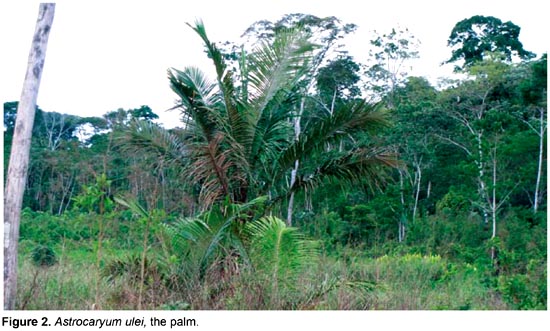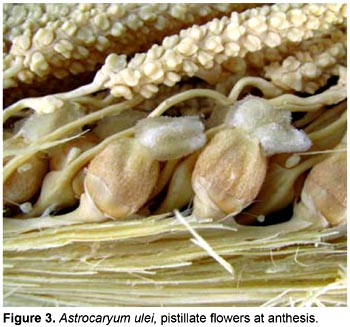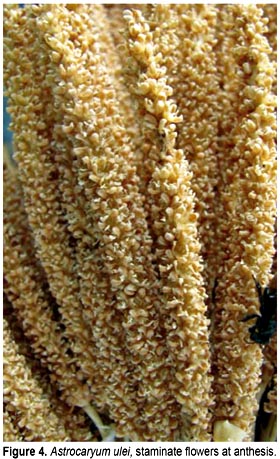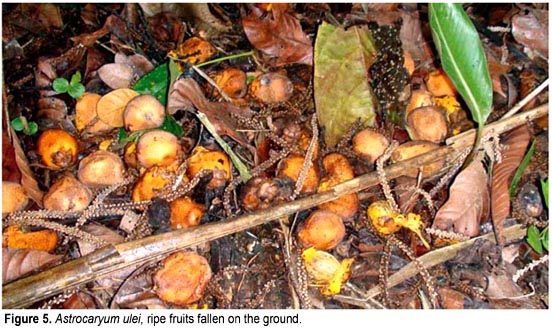Servicios Personalizados
Revista
Articulo
Indicadores
-
 Citado por SciELO
Citado por SciELO
Links relacionados
-
 Similares en
SciELO
Similares en
SciELO  uBio
uBio
Compartir
Revista Peruana de Biología
versión On-line ISSN 1727-9933
Rev. peru biol. v.16 n.2 Lima dic. 2009
TRABAJOS ORIGINALES
Astrocaryum ulei (Arecaceae) newly discovered in Peru
Astrocaryum ulei (Arecaceae), nuevo registro para el Perú
Francis Kahn1 and Betty Millán2
1 IRD, UMR188-DIAPC, DYNADIV, Casilla 18-1209, Lima, Perú. Email Francis Kahn: francis.kahn@ird.fr
2 Museo de Historia Natural, Universidad Nacional Mayor de San Marcos, Avenida Arenales 1256, Jesús María, Apdo. 14-0434, Lima 14, Perú. Email Betty Millán: bmillans@gmail.com
Abstract
Astrocaryum ulei, previously known from Brazil and Bolivia, is here reported from Madre de Dios in Peru. Based on the new material collected it has been possible to write an amended description of this species, which is presented here.
Keywords: Palms, Astrocaryum, Peru.
Resumen
Se registra para la flora peruana a la especie Astrocaryum ulei presente en Madre de Dios, conocida antes para Brasil y Bolivia. Se presenta una descripción actualizada de la especie.
Palabras clave: Palmeras, Astrocaryum, Perú.
The genus Astrocaryum is represented in the western and subandean regions of the Amazon basin by 14 species in Peru, two species (Astrocaryum ciliatum and A. ferrugineum) in Colombia and one (Astrocaryum ulei) in Brazil and Bolivia (Kahn 2008).
Astrocaryum ulei was originally described from Brazil, where it is frequent in the States of Acre and Rondônia and extends northwards in the State of Amazonas to the southern margin of Rio Solimões (illustrations: Kahn and Millán 1992; Lorenzi et al. 1996). It also grows in Bolivia (Boom 4154, NY), where it was identified as Astrocaryum huicungo (Boom 1988) or synonymized together with A. gratum and A. chonta under A. murumuru (Moraes 2004).
Astrocaryum ulei was recently found in Madre de Dios, Peru, where it is common along the road Puerto Maldonado-Iñapari, continuously present from the northern margin of the river Madre de Dios to the Brazilian border (Fig. 1). The species forms small stands on poorly-drained soils; it is usually caespitose with a trunk 1-8 m high, and with several suckers from the base. It is also found in terra firme forest and in open areas and pastures (Fig. 2), where it usually grows as a solitary palm. The local name of the palm is "huicungo". Liquid endosperm of unripe fruit is commonly drunk in Peru; the mesocarp of the ripe fruit is fleshy and eaten by the Natives in Bolivia (Boom 1988).

We did not encounter Astrocaryum ulei on the southern side of the river Madre de Dios, where it is replaced by Astrocaryum gratum that is distributed all the way to the Andean foothills in Cusco and Puno Departments and in Bolivia. The two species are easy to distinguish on the basis of the following characters: (i) pistillate flower, the calyx is cup-shaped and much shorter than the corolla in Astrocaryum ulei; it is pitcher-shaped and longer than the corolla in A. gratum; (ii) perianth in fruit, with a staminodial ring forming a regular disk slightly crenulate in A. ulei; staminodial ring lobed and 6-toothed in A. gratum; (iii) Astrocaryum gratum is never caespitose and the trunk frequently reaches up to 15 m in height.
Botanical vouchers collected in Peru are conserved at the herbarium (USM) of the Museo de Historia Natural, Universidad Nacional Mayor de San Marcos, Lima, Peru.
Astrocaryum ulei Burret
Repert. Spec. Nov. Regni Veg., 35:114, 1934.
Type: Ule 106, Acre River, Brazil (MG?).
Medium-sized, caespitose or solitary palm. Trunk up to 8 m high and 30 cm in diameter, bare and conspicuously marked with leaf scars, unarmed, covered in the upper part with leaf sheaths. Leaves 8-12, up to 600 cm long; sheath and petiole up to 120 cm long, armed with flattened, grey to brown floccose, black spines, up to 30 cm long and 1 cm wide in the proximal part; rachis up to 510 cm long, armed with black spines; pinnae 85-106 per side, regularly arranged in one plane; proximal pinnae 70-75 cm long, 2-2,5 cm wide; middle pinnae 100-105 cm long, 5-6 cm wide; distal pinnae 27-47 cm long, sometimes several connate, 2-2,5 cm wide. Inflorescence erect; prophyll 55 cm long, densely brown setose; peduncular bract to 95 cm long, proximal part covered with brown, 2-4 mm long bristles, these usually not persistent, and grey floccose, flattened, black spines, distal part with flattened, black, up to 5 cm long spines; peduncle to 130 cm long, 3,2 x 4,1 cm in cross section, proximal part tomentose, distal part spiny; rachis 23-38 cm long; rachillae many, to 14 cm long, proximal part 1-5 cm long, glabrous, distal part bearing the pistillate flowers, 3,5-9 cm long, covered with minute, clavate, hyaline hairs, only one pistillate flower inserted 0,2-1,5 cm from the rachis. Staminate flower with 3 sepals 0,5-0,7 mm long; petals 3, 2,5-3 mm long, connate in the proximal part; stamens 6, anthers 1-1,2 mm long, filaments 1,5 mm long; pistillode minute, 3-parted. Pistillate flower 11-17 mm long including stigmas; calyx glabrous, pergaminaceous, cup-shaped, tridenticulate, 2,5-3 mm long; corolla oblong to cask-shaped, more or less asymmetrical, 7-10 mm long, armed with many short and brown spines; staminodial ring entire, 2,5-5 mm long; pistil cone-shaped, tomentose, covered with bristles, these soft, zigzag, whitish in the proximal part, black in the distal part; stigmas 3, 3,5-6 mm long. Fruit subglobose, obovoid to turbinate, laterally flattened, 2,5-3,5 cm x 1,7-2,6 cm wide, 3,1-6,2 cm long including a 2-4 mm long beak, with a pedicel (base of the rachilla) to 3 cm long; exocarp yellow to brown, covered with black bristles 1-3 mm long; mesocarp yellow, fleshy, fibrous, 2-5 mm thick; endocarp 2,1-4 cm long, asymmetrical, ovoid to turbinate and acute basally. Fruiting perianth with corolla 9-14 mm long, cup-shaped, deeply crenate, brown setose in the distal part; staminodial ring shaped as a regular disk, minutely crenulate, 5-8 mm long; calyx 3-9 mm long, glabrous, divided in 3-5 lobes, limb usually ivory-white, brown distally.
Material collected from Peru (USM) - F. Kahn 4459, 1 Nov. 2008, 276 m, 10°58'54"S, 69°33'33"W; 4460, 306 m, 11°33'51"S, 69°17'26"W; 4461, 2 Nov. 2008, 179 m, 12°31'48"S, 69°04'44"W; 4462, 264 m, 12°13'09"S, 69°08'06"W; 4463, 165 m, 12°32'14"S, 69°08'28"W; 4465, 22 Feb. 2009, 170 m, 12°30'21"S, 68°48'05"W; 4469, 210 m, 12°32'16"S, 69°08'22"W; 4470, 26 Feb. 2009, 237 m; 12°10'43"S, 69°06'49"W.




Acknowledgments
This work was done under the agreement between UNMSM/Universidad Nacional Mayor de San Marcos, Peru and IRD/Institut de Recherche pour le Développement (UMR DIAPC), France, and supported by the PALMS project funded by the European Community, 7th Framework Programme, Grant Agreement N°212631. We thank Henrik Balslev and J.-C. Pintaud for their comments on the manuscript.
Literature cited
Boom B. M. 1988. The Chácobo indians and their palms. Adv. Econ. Bot., 6: 91-97. [ Links ]
Kahn F. 2008. The genus Astrocaryum (Arecaceae). Rev. peru Biol. 15 supl.1: 31-48.
Kahn F. & B. Millán. 1992. Astrocaryum (Palmae) in Amazonia. A preliminary treatment. Bull. Inst. fr. Ét. and. 21 (2): 459-531.
Lorenzi H., H.M. de Souza, J.T. de Medeiros-Costa, L.S.C. de Cerqueira & N. von Behr. 1996. Palmeiras no Brasil: nativas e exóticas. Editora Plantarum, Nova Odessa, São Paulo.
Moraes M. 2004. Flora de palmeras de Bolivia. Universidad Mayor de San Andrés. La Paz.
Presentado: 12/08/2009
Aceptado: 30/11/2009
Publicado online: 12/01/2010













